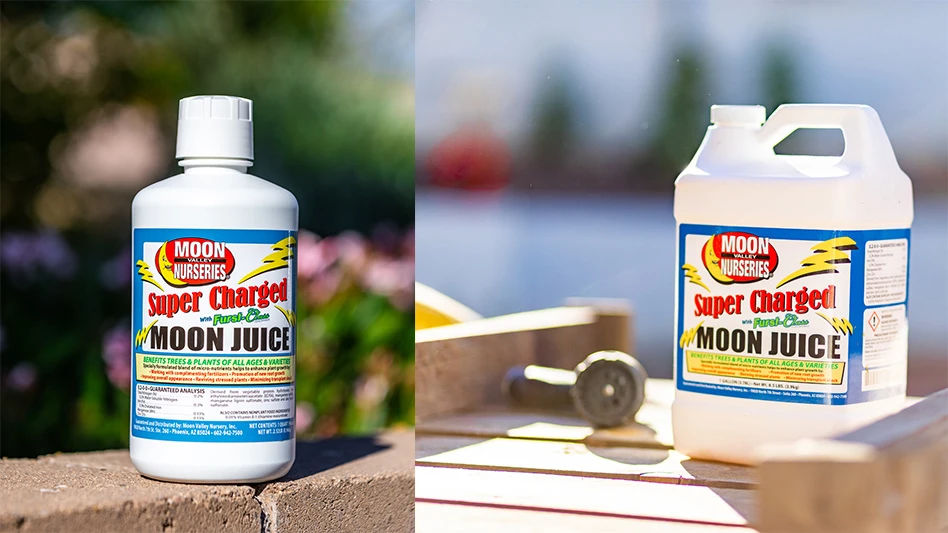Container culture has become widespread in the nursery industry, because it is so handy for the growers and their customers. But if the plants had a vote, they might have demanded to be planted in the ground instead. Good drainage is an absolute requirement for container mix. When this requirement is not met, root rot may result—because plant pathogens can capitalize on poor conditions in growing media.
 Pythium caused these marigolds to wilt. Check the roots for problems. Photo by Margery Daughtrey |
Pythium root rot
Pythium is an oomycete pathogen, also known as a water mold. The first indication of Pythium root rot may be wilting of plants that have been growing well. Inspection of roots will show that (usually at the bottom of the pot) roots have become brown or greyish, and the cortex will slough off easily. Pulling a plant from its container is often easy, as the roots provide no resistance once rotted. A rat-tail appearance at the root tips is characteristic of this disease. To catch the disease before it is too late for treatment, look at root system development periodically and watch for uneven growth across the crop. Watch for plants that look off-color or show interveinal chlorosis, purpling or yellowing of leaves, starting with the lowest leaves.
Pythium is the most ubiquitous of the root loving pathogens. It is really more than one threat, because there are numerous species that operate under different environmental conditions. Pythium aphanidermatum is an aggressive Pythium species that functions most dramatically under high-temperature, summer conditions. Biological controls do not stand up well to this fast-growing Pythium in conducive conditions, so preventive fungicide actions are important.
Under cooler weather conditions, P. ultimum and P. irregulare will capitalize on the moisture in container mix, especially if crops are overfertilized, and cause root rot losses. These organisms have broad host ranges: P. irregulare, for example, has more than 300 plant hosts. Many herbaceous perennials, including sidalceas and hellebores, can be affected by Pythium root rot. Even the occasional woody plant (boxwood for example) can be seen with Pythium problems. Sometimes adjustments in fertility and watering practices are all that’s needed to correct this, while sometimes biological or chemical controls are needed. Biocontrols containing Trichoderma, Streptomyces or Bacillus species all work to suppress Pythium in the root environment. Some fungicides with strong ability to thwart Pythium are etridiazole, cyazofamid and mefenoxam. In some nurseries, Pythium populations with resistance to mefenoxam are prevalent, so this fungicide should only be used within a rotational scheme also featuring the other two active ingredients.
Essential cultural controls for Pythium include general sanitation, using a mix with good drainage properties, using a production surface that drains well after rain or irrigation, not burying the stem when transplanting, not overfertilizing and not allowing the growing medium to dry out excessively which causes root injury. Check the appearance of roots on incoming liners.
 Phytophthora on rosemary. Photo by J. Jedrys |
Phytophthora
The other water mold that threatens roots in the nursery is Phytophthora. The genus Phytophthora also includes multiple species that can affect plants and a number of them having broad host ranges. Phytophthora attack is commonly associated with plants in the Ericaceae family such as rhododendron, azalea, andromeda and mountain laurel, but other woody species such as forsythia, viburnum and boxwood can be attacked. Daphne is extraordinarily vulnerable to this pathogen group, as is lavender.
Phytophthora pathogens can be problematic in the production of herbaceous perennials, especially if the nursery is troubled by flooding after heavy rains. Puddling and splashing are ideal for the Phytophthora pathogens. In addition to causing root and crown rots, Phytophthora sometimes is splashed up to cause shoot blights. Besides the regular problems that can develop with Phytophthora species in the nursery, there is now the additional spectre of the federally-regulated pathogen P. ramorum, the agent of ramorum blight/sudden oak death. P. ramorum is able to cause the same kinds of shoot blight that would ordinarily be associated with P. citricola or P. cactorum, etc., but on some hosts the symptoms are insignificant looking leaf spots, making detection very challenging.
There are many fungicides available for Phytophthora management. As with Pythium, it is important to correct any cultural errors before bothering to use fungicides for insurance against Phytophthora. Good sanitation and good drainage in the medium (and from the surface on which the plants are set) are the primary cultural safeguards against Phytophthora. The fungicides that work against Pythium also work against Phytophthora, plus there is also effective control from dimethomorph, mandipropamid, strobilurins and phosphorous acids.
Rhizoctonia
Rhizoctonia, unlike Pythium and Phytophthora, is a true fungus. It is an extremely widespread soil-dweller, which often devils field production and sometimes gains access to plants in container culture. The pathogen, Rhizoctonia solani, is another important focus of sanitation efforts—field soil contamination of container mix is the usual source of trouble.
Rhizoctonia attacks at the soil line most often, causing brown cankers at the base of the stems of herbaceous perennials. On some woody crops, such as roses, it may act as a bona fide root rot, causing brown-discolored roots. In either case, the result is stunting, or wilted, dying plants. Mulching plants around the stem may increase the effect of Rhizoctonia by providing a zone of high humidity right at the stem base that increases the likelihood of infection. Of the pathogens listed here, only Rhizoctonia can be a problem under good cultural conditions; it does not need an over-watered situation to attack plant stems or roots.
The fungicides useful against Rhizoctonia include thiophanate-methyl, iprodione, flutolanil, fludioxonil, triflumizole, polyoxin D and PCNB.
 Fusarium is more of a vascular wilt pathogen than a root rotter. Photo by Margery Daughtrey |
Fusarium
Fusarium is more famous as a vascular wilt pathogen than a root rotter. Some crops—like chrysanthemum, coreopsis and basil—are subject to vascular wilts caused by different subspecies of Fusarium oxysporum. For wilt diseases, the trick is to keep the pH at 6.2 or higher, which is often achieved by using a nitrate form of nitrogen on the Fusarium wilt sensitive crops. Other Fusarium species cause root rot and stem rot. Usually Fusarium will only attack dramatically when there is a poorly drained soil situation, or a high ammonium nitrogen level. During greenhouse propagation, keep fungus gnats under control, as they have been shown to move Fusarium spores around. The fungicides that work against Fusarium include thiophanate-methyl, fludioxonil and triflumizole.
Thielaviopsis
Black root rot is another fungus-caused root problem that may affect many plants. Among the woodies, usually it is the Japanese hollies that are troubled by Thielaviopsis basicola, the agent of black root rot. Many herbaceous perennials are susceptible, including astilbe, vinca, rosemary, gaillardia, Shasta daisy, aquilegia, tiarella, dianthus, dicentra, phlox, geranium and heuchera.
The symptoms of black root rot do include black roots at times, but these are not always obvious. The most conspicuous symptom is stunting of the crop—but this is not a uniform stunting across the crop. Some plants will be full size, while others are small and purplish or yellowed. Close examination of the roots of these stunted plants under a microscope will allow a scout to find the telltale brown chlamydospores of the fungus.
Controlling fungus gnats and shore flies is important for management of black root rot. The disease is often carried forward from one season to another on flats or pots from discarded plants. Wash and disinfest before reusing any growing containers. Keeping the growing pH low is a control for black root rot, but achieving useful control would require an unacceptably low pH of 4.8. Avoiding high pH (above 6.0), in conjunction with fungicide use, will help to keep the disease from being severe.
Fungicides for black root rot control include thiophanate-methyl, which outperforms other fungicides in research trials. Because this is a FRAC Group 1 fungicide, very prone to resistance development, it is critical to rotate it with other materials in other FRAC Groups, such as fludioxonil, triflumizole and polyoxin D.
Margery Daughtrey is senior extension associate at Cornell University, Long Island Horticultural Research & Extension Center in Riverhead, N.Y., mld9@cornell.edu.

Explore the August 2013 Issue
Check out more from this issue and find your next story to read.
Latest from Nursery Management
- Society of American Florists accepting entries for 2025 Marketer of the Year Contest
- Sustainabloom launches Wholesale Nickel Program to support floriculture sustainability
- American Horticultural Society welcomes five new board members
- Get to know Christopher Brown Jr. of Lancaster Farms
- American Floral Endowment establishes Demaree Family Floriculture Advancement Fund
- The Growth Industry Episode 3: Across the Pond with Neville Stein
- The Growth Industry Episode 2: Emily Showalter on how Willoway Nurseries transformed its business
- March 2025 issue recap






